Munson B.R. Fundamentals of Fluid Mechanics
Подождите немного. Документ загружается.

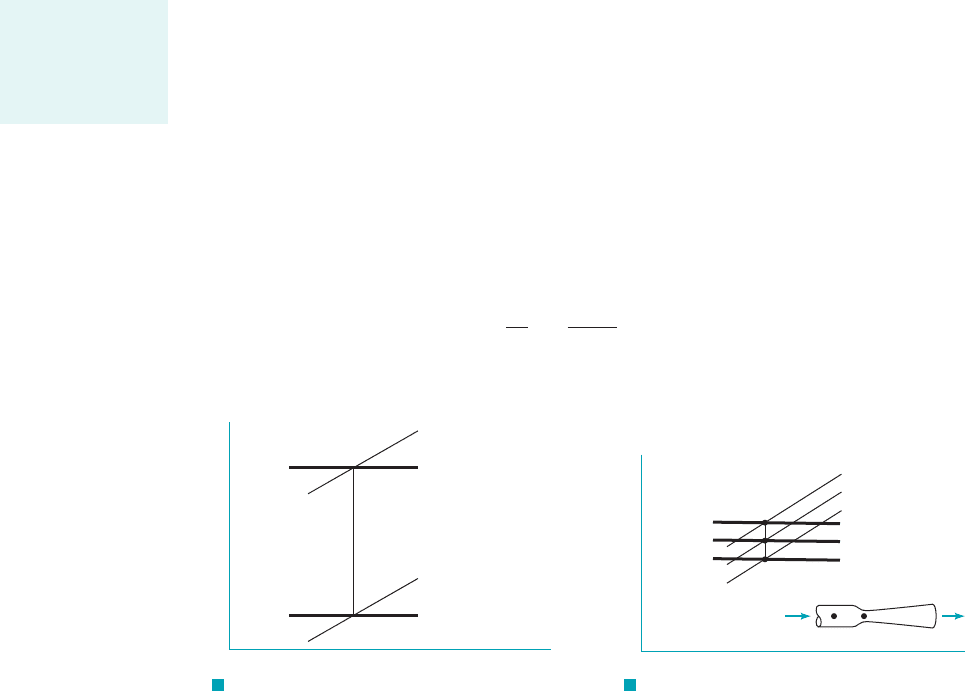
A very useful means of keeping track of the states of an isentropic flow of an ideal gas in-
volves a temperature–entropy (T–s) diagram, as is shown in Fig. 11.7. Experience has shown
1see, for example, Refs. 2 and 32that lines of constant pressure are generally as are sketched in
Fig. 11.7. An isentropic flow is confined to a vertical line on a T–sdiagram. The vertical line in
Fig. 11.7 is representative of flow between the stagnation state and any state within the converging–
diverging nozzle. Equation 11.56 shows that fluid temperature decreases with an increase in Mach
number. Thus, the lower temperature levels on a T–sdiagram correspond to higher Mach num-
bers. Equation 11.59 suggests that fluid pressure also decreases with an increase in Mach num-
ber. Thus, lower fluid temperatures and pressures are associated with higher Mach numbers in
our isentropic converging–diverging duct example.
One way to produce flow through a converging–diverging duct like the one in Fig. 11.6a is
to connect the downstream end of the duct to a vacuum pump. When the pressure at the down-
stream end of the duct 1the back pressure2is decreased slightly, air will flow from the atmosphere
through the duct and vacuum pump. Neglecting friction and heat transfer and considering the air
to act as an ideal gas, Eqs. 11.56, 11.59, and 11.60 and a T–sdiagram can be used to describe
steady flow through the converging–diverging duct.
If the pressure in the duct is only slightly less than atmospheric pressure, we predict with
Eq. 11.59 that the Mach number levels in the duct will be low. Thus, with Eq. 11.60 we conclude
that the variation of fluid density in the duct is also small. The continuity equation 1Eq. 11.402leads
us to state that there is a small amount of fluid flow acceleration in the converging portion of the
duct followed by flow deceleration in the diverging portion of the duct. We considered this type
of flow when we discussed the Venturi meter in Section 3.6.3. The T–sdiagram for this flow is
sketched in Fig. 11.8.
We next consider what happens when the back pressure is lowered further. Since the flow
starts from rest upstream of the converging portion of the duct of Fig. 11.6a, Eqs. 11.48 and
11.50 reveal to us that flow up to the nozzle throat can be accelerated to a maximum allowable
Mach number of 1 at the throat. Thus, when the duct back pressure is lowered sufficiently, the
Mach number at the throat of the duct will be 1. Any further decrease of the back pressure will
not affect the flow in the converging portion of the duct because, as is discussed in Section
11.3, information about pressure cannot move upstream when When at the throat
of the converging–diverging duct, we have a condition called choked flow. Some useful equa-
tions for choked flow are developed below.
We have already used the stagnation state for which as a reference condition. It will
prove helpful to us to use the state associated with and the same entropy level as the flow-
ing fluid as another reference condition we shall call the critical state, denoted
The ratio of pressure at the converging–diverging duct throat for choked flow, to stagna-
tion pressure, is referred to as the critical pressure ratio. By substituting into Eq. 11.59
we obtain
(11.61)
p*
p
0
⫽ a
2
k ⫹ 1
b
k
Ⲑ
1k⫺12
Ma ⫽ 1p
0
,
p*,
12*.
Ma ⫽ 1
Ma ⫽ 0
Ma ⫽ 1Ma ⫽ 1.
11.4 Isentropic Flow of an Ideal Gas 597
F I G U R E 11.7 The (T–s)
diagram relating stagnation and static states.
T
s
T
p
p
0
T
0
F I G U R E 11.8 The T – s diagram
for Venturi meter flow.
T
s
(1) (2)
T
2
T
1
T
0
p
0
p
1
p
2
Choked flow occurs
when the Mach
number is 1.0 at
the minimum cross-
sectional area.
JWCL068_ch11_579-644.qxd 9/25/08 8:18 PM Page 597
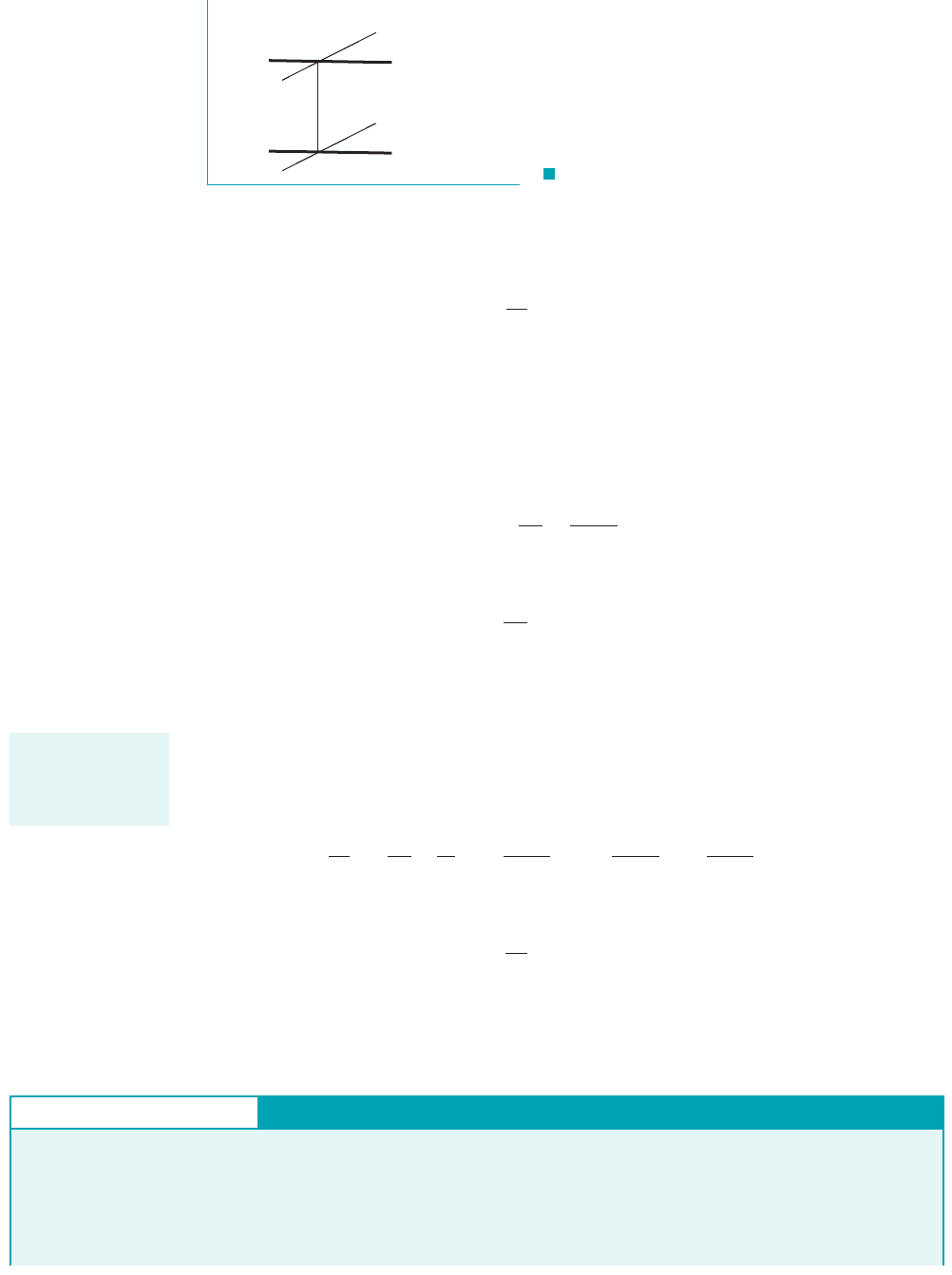
For the nominal value of k for air, Eq. 11.61 yields
(11.62)
Because the stagnation pressure for our converging–diverging duct example is the atmospheric pres-
sure, the throat pressure for choked air flow is, from Eq. 11.62
We can get a relationship for the critical temperature ratio, by substituting
into Eq. 11.56. Thus,
(11.63)
or for
(11.64)
For the duct of Fig. 11.6a, Eq. 11.64 yields
The stagnation and critical pressures and temperatures are shown on the T–s diagram of
Fig. 11.9.
When we combine the ideal gas equation of state 1Eq. 11.12with Eqs. 11.61 and 11.63, for
we get
(11.65)
For air Eq. 11.65 leads to
(11.66)
and we see that when the converging–diverging duct flow is choked, the density of the air at the
duct throat is 63.4% of the density of atmospheric air.
a
r*
r
0
b
k⫽1.4
⫽ 0.634
1k ⫽ 1.42,
r*
r
0
⫽ a
p*
T*
b a
T
0
p
0
b⫽ a
2
k ⫹ 1
b
k
Ⲑ
1k⫺12
a
k ⫹ 1
2
b⫽ a
2
k ⫹ 1
b
1
Ⲑ
1k⫺12
Ma ⫽ 1
T*
k
⫽1.4
⫽ 0.833T
atm
a
T*
T
0
b
k⫽1.4
⫽ 0.833
k ⫽ 1.4
T*
T
0
⫽
2
k ⫹ 1
Ma ⫽ 1T*
Ⲑ
T
0
,
p
*
k⫽1.4
⫽ 0.528p
atm
p
atm
,
a
p*
p
0
b
k⫽1.4
⫽ 0.528
k ⫽ 1.4,
598 Chapter 11 ■ Compressible Flow
The stagnation and
critical states are at
the same entropy
level.
GIVEN A converging duct passes air steadily from standard
atmospheric conditions to a receiver pipe as illustrated in Fig.
E11.5a. The throat 1minimum2flow cross-sectional area of the con-
verging duct is . The receiver pressure is 1a280 kPa
1abs2, 1b240 kPa 1abs2.
1 ⫻ 10
⫺4
m
2
FIND Determine the mass flowrate through the duct and
sketch temperature–entropy diagrams for situations 1a2and 1b2.
Isentropic Flow in a Converging Duct
E
XAMPLE 11.5
F I G U R E 11.9 The relationship
between the stagnation and critical states.
T
T
* =
T
0
p
0
T
0
s
( )
2
______
k + 1
p* = p
0
( )
2
______
k + 1
(
)
k
______
k – 1
JWCL068_ch11_579-644.qxd 9/25/08 8:18 PM Page 598
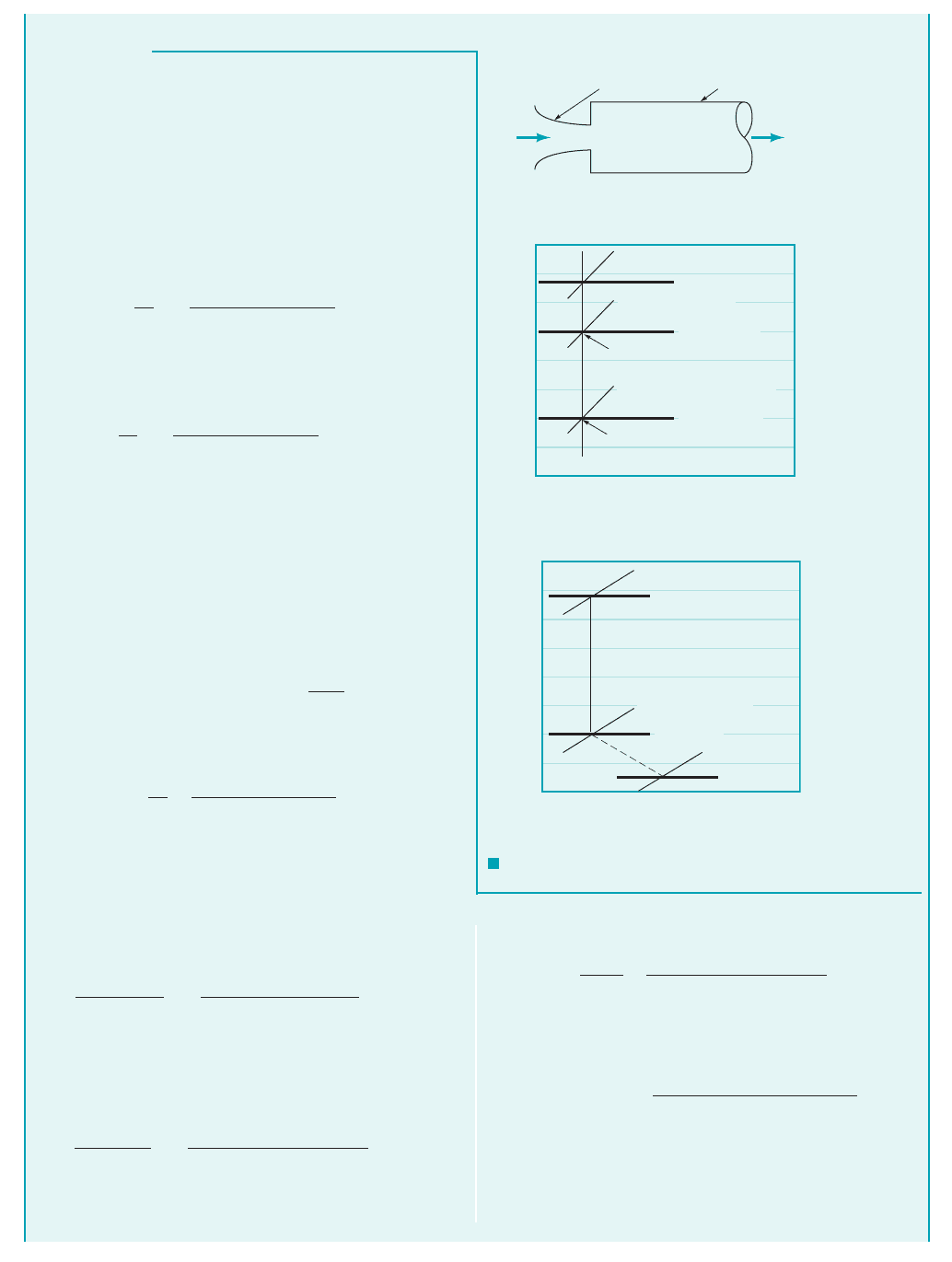
11.4 Isentropic Flow of an Ideal Gas 599
S
OLUTION
From Eq. 5
or
Substituting into Eq. 4 we obtain
Thus, since
we obtain
V
th
⫽ 193 m
Ⲑ
s
1m
Ⲑ
s2
2
,
1 J
Ⲑ
kg ⫽ 1 N
#
m
Ⲑ
kg ⫽ 1 1kg
#
m
Ⲑ
s
2
2
#
m
Ⲑ
kg ⫽
⫽ 193 1J
Ⲑ
kg2
1
Ⲑ
2
V
th
⫽ 0.587 23286.9 J
Ⲑ
1kg
#
K241269 K211.42
Ma
th
⫽ 0.587 and T
th
⫽ 269 K
T
th
⫽ 269 K
T
th
288 K
⫽
1
1 ⫹ 311.4 ⫺ 12
Ⲑ
2410.5872
2
To determine the mass flowrate through the converging duct we
use Eq. 11.40. Thus,
or in terms of the given throat area,
(1)
We assume that the flow through the converging duct is isen-
tropic and that the air behaves as an ideal gas with constant and
Then, from Eq. 11.60
(2)
The stagnation density, for the standard atmosphere is
and the specific heat ratio is 1.4. To determine the
throat Mach number, we can use Eq. 11.59,
(3)
The critical pressure, is obtained from Eq. 11.62 as
If the receiver pressure, is greater than or equal to then
If then and the flow is choked. With
and k known, can be obtained from Eq. 3, and can
be determined from Eq. 2.
The flow velocity at the throat can be obtained from Eqs.
11.36 and 11.46 as
(4)
The value of temperature at the throat, can be calculated from
Eq. 11.56,
(5)
Since the flow through the converging duct is assumed to be isen-
tropic, the stagnation temperature is considered constant at the
standard atmosphere value of
Note that absolute pressures and temperatures are used.
(a) For we have
kPa1abs2. Then from Eq. 3
or
From Eq. 2
or
r
th
⫽ 1.04 kg
Ⲑ
m
3
r
th
1.23 kg
Ⲑ
m
3
⫽ e
1
1 ⫹ 311.4 ⫺ 12
Ⲑ
2410.5872
2
f
1
Ⲑ
11.4⫺12
Ma
th
⫽ 0.587
80 kPa1abs2
101 kPa1abs2
⫽ e
1
1 ⫹ 311.4 ⫺ 12
Ⲑ
24Ma
2
th
f
1.4
Ⲑ
11.4⫺12
p
th
⫽ 80
p
re
⫽ 80 kPa1abs27 53.3 kPa1abs2⫽ p*,
288 K.T
0
⫽ 15 K ⫹ 273 K ⫽
T
th
T
0
⫽
1
1 ⫹ 31k ⫺ 12
Ⲑ
24Ma
2
th
T
th
,
V
th
⫽ Ma
th
c
th
⫽ Ma
th
2RT
th
k
r
th
Ma
th
p
th
, p
0
,
p
th
⫽ p*p
re
6 p*,p
th
⫽ p
re
.
p*,p
re
,
⫽ 10.52823101 kPa1abs24⫽ 53.3 kPa1abs2
p*
⫽ 0.528p
0
⫽ 0.528p
atm
p*,
p
th
p
0
⫽ e
1
1 ⫹ 31k ⫺ 12
Ⲑ
24Ma
2
th
f
k
Ⲑ
1k⫺12
Ma
th
,
1.23 kg
Ⲑ
m
3
r
0
,
r
th
r
0
⫽ e
1
1 ⫹ 31k ⫺ 12
Ⲑ
24Ma
2
th
f
1
Ⲑ
1k⫺12
c
v
.
c
p
m
#
⫽ r
th
A
th
V
th
A
th
,
m
#
⫽ rAV ⫽ constant
F I G U R E E11.5
T
re
< T*
p
re
< p*
300
290
280
270
260
250
240
230
220
T, K
J
_______
(kg • K)
s,
(c)
T* = 240 K
p* = 53.3 kPa (abs)
p
0
= 101 kPa (abs)
T
0
= 288 K
300
290
280
270
260
250
240
230
220
Situation (
b)
Situation (
a)
T
th, b
= 240 K
T
th,
a
= 269 K
T
0
= 288 K
p
th, b
= 53.3 kPa (abs) = p*
p
th, a
= 80 kPa (abs)
p
0
= 101 kPa (abs)
T, K
J
_______
(kg • K)
s,
(b)
Flow
Standard
atmosphere
Converging duct Receiver pipe
(a)
JWCL068_ch11_579-644.qxd 9/25/08 8:18 PM Page 599

Isentropic flow Eqs. 11.56, 11.59, and 11.60 have been used to construct Fig. D.1 in Appen-
dix D for air Examples 11.6 and 11.7 illustrate how these graphs of and
as a function of Mach number, Ma, can be used to solve compressible flow problems.
r
Ⲑ
r
0
p
Ⲑ
p
0
,T
Ⲑ
T
0
,1k ⫽ 1.42.
600 Chapter 11 ■ Compressible Flow
Finally from Eq. 1 we have
(Ans)
(b) For we have
and The converging duct is
choked. From Eq. 2 1see also Eq. 11.662
or
From Eq. 5 1see also Eq. 11.642,
or
T
th
⫽ 240 K
T
th
288 K
⫽
1
1 ⫹ 311.4 ⫺ 12
Ⲑ
24112
2
r
th
⫽ 0.780 kg
Ⲑ
m
3
r
th
1.23 kg
Ⲑ
m
3
⫽ e
1
1 ⫹ 311.4 ⫺ 12
Ⲑ
24112
2
f
1
Ⲑ
11.4⫺12
Ma
th
⫽ 1.p
th
⫽ p* ⫽ 53.3 kPa1abs2
p
re
⫽ 40 kPa1abs2⬍ 53.3 kPa1abs2⫽ p*,
⫽ 0.0201 kg
Ⲑ
s
m
#
⫽ 11.04 kg
Ⲑ
m
3
211 ⫻ 10
⫺4
m
2
21193 m
Ⲑ
s2
From Eq. 4,
since Finally
from Eq. 1
(Ans)
From the values of throat temperature and throat pressure cal-
culated above for flow situations 1a2and 1b2, we can construct the
temperature–entropy diagram shown in Fig. E11.5b.
COMMENT Note that the flow from standard atmosphere to
the receiver for receiver pressure, greater than or equal to the
critical pressure, is isentropic. When the receiver pressure is
less than the critical pressure as in situation 1b2above, what is the
flow like downstream from the exit of the converging duct? Expe-
rience suggests that this flow, when is three-
dimensional and nonisentropic and involves a drop in pressure
from to a drop in temperature, and an increase of entropy
as are indicated in Fig. E11.5c.
p
re
,p
th
p
re
6 p*,
p*,
p
re
,
⫽ 0.0242 kg
Ⲑ
s
m
#
⫽ 10.780 kg
Ⲑ
m
3
211 ⫻ 10
⫺4
m
2
21310 m
Ⲑ
s2
1 J
Ⲑ
kg ⫽1 N
#
m
Ⲑ
kg ⫽1 1kg
#
m
Ⲑ
s
2
2
#
m
Ⲑ
kg ⫽ 1m
Ⲑ
s2
2
.
⫽ 310 1J
Ⲑ
kg2
1
Ⲑ
2
⫽ 310 m
Ⲑ
s
V
th
⫽ 112 23286.9 J
Ⲑ
1kg
#
K241240 K211.42
GIVEN Consider the flow described in Example 11.5.
Use of Compressible Flow Graphs in Solving Problems
E
XAMPLE 11.6
S
OLUTION
Thus, from Eqs. 2 and 3
and
Furthermore, using Eqs. 11.36 and 11.46 we get
since Fi-
nally, from Eq. 1
(Ans)
⫽ 0.0202 kg
Ⲑ
s
m
#
⫽ 11.04 kg
Ⲑ
m
3
211 ⫻ 10
⫺4
m
2
21194 m
Ⲑ
s2
1 J
Ⲑ
kg ⫽ 1 N
#
m
Ⲑ
kg ⫽ 1 1kg
#
m
Ⲑ
s
2
2
#
m
Ⲑ
kg ⫽ 1m
Ⲑ
s2
2
.
⫽ 194 1J
Ⲑ
kg2
1
Ⲑ
2
⫽ 194 m
Ⲑ
s
⫽ 10.592 23286.9 J
Ⲑ
1kg
#
K241269 K211.42
V
th
⫽ Ma
th
2RT
th
k
r
th
⫽ 10.85211.23 kg
Ⲑ
m
3
2⫽ 1.04 kg
Ⲑ
m
3
T
th
⫽ 10.9421288 K2⫽ 271 K
We still need the density and velocity of the air at the converging
duct throat to solve for mass flowrate from
(1)
(a) Since the receiver pressure, is greater
than the critical pressure, the throat pres-
sure, is equal to the receiver pressure. Thus
From Fig. D.1, for we get from the graph
(2)
(3)
r
th
r
0
⫽ 0.85
T
th
T
0
⫽ 0.94
Ma
th
⫽ 0.59
p
Ⲑ
p
0
⫽ 0.79,
p
th
p
0
⫽
80 kPa1abs2
101 kPa1abs2
⫽ 0.792
p
th
,
p* ⫽ 53.3 kPa1abs2,
p
re
⫽ 80 kPa1abs2,
m
#
⫽ r
th
A
th
V
th
FIND Solve Example 11.5 using Fig. D.1 of Appendix D.
JWCL068_ch11_579-644.qxd 9/25/08 8:18 PM Page 600

11.4 Isentropic Flow of an Ideal Gas 601
(b) For the throat
pressure is equal to 53.3 kPa1abs2and the duct is choked with
From Fig. D.1, for we get
(4)
and
(5)
From Eqs. 4 and 5 we obtain
and
r
th
⫽ 10.64211.23 kg
Ⲑ
m
3
2⫽ 0.79 kg
Ⲑ
m
3
T
th
⫽ 10.8321288 K2⫽ 240 K
r
th
r
0
⫽ 0.64
T
th
T
0
⫽ 0.83
Ma ⫽ 1Ma
th
⫽ 1.
p
re
⫽ 40 kPa1abs26 53.3 kPa1abs2⫽ p*,
Also, from Eqs. 11.36 and 11.46 we conclude that
Then, from Eq. 1
(Ans)
COMMENT
The values from Fig. D.1 resulted in answers
for mass flowrate that are close to those using the ideal gas equa-
tions 1see Example 11.52.
The temperature–entropy diagrams remain the same as those
provided in the solution of Example 11.5.
⫽ 0.024 kg
Ⲑ
s
m
#
⫽ 10.79 kg
Ⲑ
m
3
211 ⫻ 10
⫺4
m
2
21310 m
Ⲑ
s2
⫽ 310 1J
Ⲑ
kg2
1
Ⲑ
2
⫽ 310 m
Ⲑ
s
⫽ 112 23286.9 J
Ⲑ
1kg
#
K241240 K211.42
V
th
⫽ Ma
th
2RT
th
k
GIVEN The static pressure to stagnation pressure ratio at a point
in a flow stream is measured with a Pitot-static tube 1see Fig. 3.62as
being equal to 0.82. The stagnation temperature of the fluid is 68 °F.
Static to Stagnation Pressure Ratio
E
XAMPLE 11.7
S
OLUTION
and using Eqs. 1, 2, and 4 we get
Thus, since it follows that
(Ans)
(b) For helium, and By substituting
these values into Eq. 11.59 we get
or
From Eq. 11.56 we obtain
Thus,
⫽ 488 °R
T ⫽ e
1
1 ⫹ 311.66 ⫺ 12
Ⲑ
2410.4992
2
f3168 ⫹ 4602 °R4
T
T
0
⫽
1
1 ⫹ 31k ⫺ 12
Ⲑ
24Ma
2
Ma ⫽ 0.499
0.82 ⫽ e
1
1 ⫹ 311.66 ⫺ 12
Ⲑ
24 Ma
2
f
1.66
Ⲑ
11.66⫺12
k ⫽ 1.66.p
Ⲑ
p
0
⫽ 0.82
⫽ 590 ft
Ⲑ
s
V ⫽ 104 1ft
#
lb
Ⲑ
lbm2
1
Ⲑ
2
3132.2 lbm
#
ft
Ⲑ
s
2
2
Ⲑ
lb4
1
Ⲑ
2
1 lb ⫽ 32.2 lbm
#
ft
Ⲑ
s
2
,
⫽ 104 1ft
#
lb
Ⲑ
lbm2
1
Ⲑ
2
V ⫽ 10.542 2353.3 1ft
#
lb2
Ⲑ
1lbm
#
°R241496 °R211.42
We consider both air and helium, flowing as described above, to
act as ideal gases with constant specific heats. Then, we can use
any of the ideal gas relationships developed in this chapter. To de-
termine the flow velocity, we can combine Eqs. 11.36 and 11.46
to obtain
(1)
By knowing the value of static to stagnation pressure ratio,
and the specific heat ratio we can obtain the corresponding Mach
number from Eq. 11.59, or for air, from Fig. D.1. Figure D.1
cannot be used for helium, since k for helium is 1.66 and Fig. D.1
is for only. With Mach number, specific heat ratio, and
stagnation temperature known, the value of static temperature can
be subsequently ascertained from Eq. 11.56 1or Fig. D.1 for air2.
(a) For air, thus from Fig. D.1,
(2)
and
(3)
Then, from Eq. 3
(4)T ⫽ 10.9423168 ⫹ 4602 °R4⫽ 496 °R
T
T
0
⫽ 0.94
Ma ⫽ 0.54
p
Ⲑ
p
0
⫽ 0.82;
k ⫽ 1.4
p
Ⲑ
p
0
,
V ⫽ Ma 2RTk
FIND Determine the flow velocity if the fluid is 1a2air, 1b2he-
lium.
JWCL068_ch11_579-644.qxd 9/25/08 8:19 PM Page 601
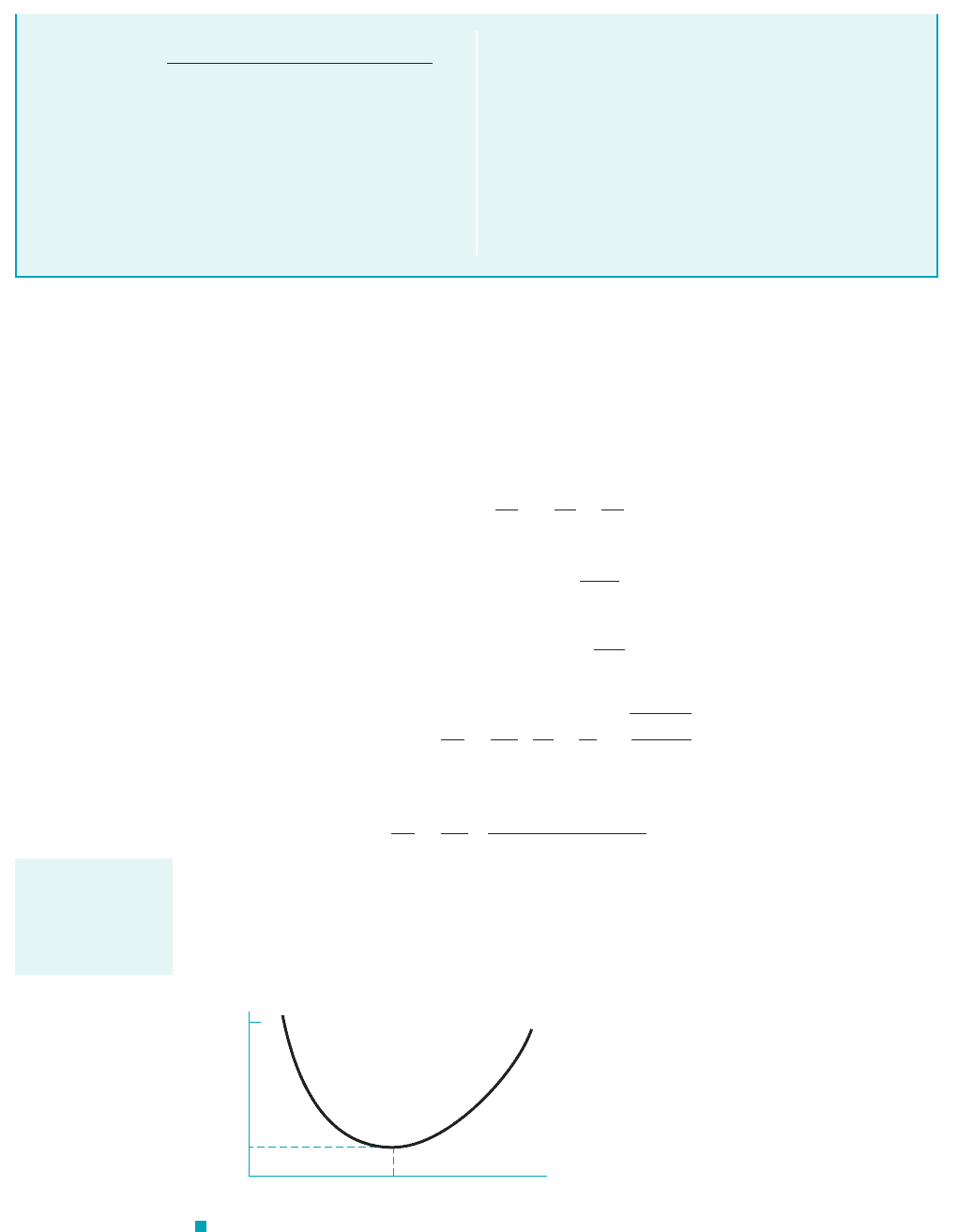
Also included in Fig. D.1 is a graph of the ratio of local area, A, to critical area, for dif-
ferent values of local Mach number. The importance of this area ratio is clarified below.
For choked flow through the converging–diverging duct of Fig. 11.6a, the conservation of
mass equation 1Eq. 11.402yields
or
(11.67)
From Eqs. 11.36 and 11.46, we obtain
(11.68)
and
(11.69)
By combining Eqs. 11.67, 11.68, and 11.69 we get
(11.70)
The incorporation of Eqs. 11.56, 11.60, 11.63, 11.65, and 11.70 results in
(11.71)
Equation 11.71 was used to generate the values of for air in Fig. D.1. These val-
ues of are graphed as a function of Mach number in Fig. 11.10. As is demonstrated in the
following examples, whether or not the critical area, is physically present in the flow, the area
ratio, is still a useful concept for the isentropic flow of an ideal gas through a converging–
diverging duct.
A
Ⲑ
A*,
A*,
A
Ⲑ
A*
1k ⫽ 1.42A
Ⲑ
A*
A
A*
⫽
1
Ma
e
1 ⫹ 31k ⫺ 12
Ⲑ
24Ma
2
1 ⫹ 31k ⫺ 12
Ⲑ
24
f
1k⫹12
Ⲑ
321k⫺ 124
A
A*
⫽
1
Ma
a
r*
r
0
b a
r
0
r
b
B
1T*
Ⲑ
T
0
2
1T
Ⲑ
T
0
2
V ⫽ Ma 1RTk
V* ⫽ 1RT*k
A
A*
⫽ a
r*
r
b a
V*
V
b
rAV ⫽ r*A*V*
A*,
602 Chapter 11 ■ Compressible Flow
From Eq. 1 we obtain
or, using
(Ans)
COMMENT Note that the isentropic flow equations and Fig.
D.1 for were used presently to describe fluid particlek ⫽ 1.4
⫽ 1580 ft
Ⲑ
s
V ⫽ 279 1ft
#
lb
Ⲑ
lbm2
1
Ⲑ
2
3132.2 lbm
#
ft
Ⲑ
s
2
2
Ⲑ
lb4
1
Ⲑ
2
1 lb ⫽ 32.2 lbm
#
ft
Ⲑ
s
2
,
⫽ 279 1ft
#
lb
Ⲑ
lbm2
1
Ⲑ
2
V ⫽ 10.4992 23386 1ft
#
lb2
Ⲑ
1lbm
#
°R241488 °R211.662
isentropic flow along a pathline in a stagnation process. Even
though these equations and graph were developed for one-
dimensional duct flows, they can be used for frictionless, adia-
batic pathline flows also.
Furthermore, while the Mach numbers calculated above are of
similar size for the air and helium flows, the flow speed is much
larger for helium than for air because the speed of sound in he-
lium is much larger than it is in air.
F I G U R E 11.10 The variation of area
ratio with Mach number for isentropic flow of an
ideal gas ( linear coordinate scales).k
k 1.4,
2.0
1.0
A
___
A*
0 1.0
Ma
The ratio of flow
area to the critical
area is a useful
concept for isen-
tropic duct flow.
JWCL068_ch11_579-644.qxd 9/25/08 8:19 PM Page 602

11.4 Isentropic Flow of an Ideal Gas 603
GIVEN Air enters subsonically from standard atmosphere and
flows isentropically through a choked converging–diverging duct
having a circular cross-sectional area, A, that varies with axial dis-
tance from the throat, x, according to the formula
where A is in square meters and x is in meters. The duct extends
from to x ⫽⫹0.5 m.x ⫽⫺0.5 m
A ⫽ 0.1 ⫹ x
2
Isentropic Choked Flow in a Converging–Diverging
Duct with Subsonic Entry
E
XAMPLE 11.8
S
OLUTION
and a graph of radius as a function of axial distance can be easily
constructed (see Fig. E11.8a).
Since the converging–diverging duct in this example is
choked, the throat area is also the critical area, From Eq. 2 we
see that
(4)
For any axial location, from Eqs. 2 and 4 we get
(5)
A
A*
⫽
0.1 ⫹ x
2
0.1
A* ⫽ 0.1 m
2
A*.
The side view of the converging–diverging duct is a graph of ra-
dius r from the duct axis as a function of axial distance. For a cir-
cular flow cross section we have
(1)
where
(2)
Thus, combining Eqs. 1 and 2, we have
(3)
r ⫽ a
0.1 ⫹ x
2
p
b
1
Ⲑ
2
A ⫽ 0.1 ⫹ x
2
A ⫽ pr
2
FIND For this flow situation, sketch the side view of the duct and
graph the variation of Mach number, static temperature to stagnation
temperature ratio, and static pressure to stagnation pressure ra-
tio, through the duct from to Also
show the possible fluid states at and us-
ing temperature–entropy coordinates.
⫹0.5 mx ⫽⫺0.5 m, 0 m,
x ⫽⫹0.5 m.x ⫽⫺0.5 mp
Ⲑ
p
0
,
T
Ⲑ
T
0
,
0.4
0.3
0.2
0.1
0
–0.5 –0.4 –0.2 0
(
a)
x, m
0.2 0.4 0.5
r, m
3.0
2.0
1.0
–0.5 –0.4 –0.2 0
x, m
Ma
0.2 0.4 0.5
Subsonic
Subsonic
Supersonic
(
b)
(
c)(d)
1.0
0.9
0.8
0.7
0.6
0.5
0.4
0.3
0.2
0.1
0.0
–0.5 –0.4 –0.2 0 0.2 0.4 0.5
x, m
T
_
__
T
0
T/T
0
p/p
0
p
_
__
p
0
Subsonic
Subsonic
Subsonic
Subsonic
Supersonic
Supersonic
310
290
270
250
230
210
190
170
150
130
110
90
0
d
b
a, c
p
d
= 4 kPa (abs)
p
b
= 54 kPa (abs)
p
a
= p
c
= 99 kPa (abs)
p
0
= 101 kPa (abs)
T
d
= 112 K
T
b
= 39 K
T
a
= T
c
= 285 K
T
0
= 288 K
T, K
J
_______
(kg • K)
s,
F I G U R E E11.8
JWCL068_ch11_579-644.qxd 9/25/08 8:19 PM Page 603

604 Chapter 11 ■ Compressible Flow
Values of from Eq. 5 can be used in Eq. 11.71 to calculate
corresponding values of Mach number, Ma. For air with
we could enter Fig. D.1 with values of and read off values of
the Mach number. With values of Mach number ascertained, we
could use Eqs. 11.56 and 11.59 to calculate related values of
and For air with Fig. D.1 could be entered with
or Ma to get values of and To solve this example,
we elect to use values from Fig. D.1.
The following table was constructed by using Eqs. 3 and 5 and
Fig. D.1.
With the air entering the choked converging–diverging duct
subsonically, only one isentropic solution exists for the converg-
ing portion of the duct. This solution involves an accelerating
flow that becomes sonic at the throat of the passage.
Two isentropic flow solutions are possible for the diverging por-
tion of the duct—one subsonic, the other supersonic. If the pres-
sure ratio, is set at 0.98 at 1the outlet2, the sub-
sonic flow will occur. Alternatively, if is set at 0.04 at
the supersonic flow field will exist. These condi-
tions are illustrated in Fig. E11.8. An unchoked subsonic flow
through the converging–diverging duct of this example is dis-
cussed in Example 11.10. Choked flows involving flows other
than the two isentropic flows in the diverging portion of the duct
of this example are discussed after Example 11.10.
COMMENT Note that if the diverging portion of this duct
is extended, larger values of and Ma are achieved. From
Fig. D1, note that further increases of result in smaller
changes of Ma after values of about 10. The ratio of p
Ⲑ
p
0
A
Ⲑ
A*
A
Ⲑ
A*
A
Ⲑ
A*
x ⫽⫹0.5 m,
p
Ⲑ
p
0
x ⫽⫹0.5 mp
Ⲑ
p
0
,
1Ma ⫽ 12
p
Ⲑ
p
0
.T
Ⲑ
T
0
A
Ⲑ
A*
k ⫽ 1.4,p
Ⲑ
p
0
.
T
Ⲑ
T
0
A
Ⲑ
A*
k ⫽ 1.4,
A
Ⲑ
A*
From From
Eq. 3, Eq. 5,
From Fig. D.1
x (m) r (m) Ma State
Subsonic Solution
0.334 3.5 0.17 0.99 0.98 a
0.288 2.6 0.23 0.99 0.97
0.246 1.9 0.32 0.98 0.93
0.211 1.4 0.47 0.96 0.86
0.187 1.1 0.69 0.91 0.73
0 0.178 1 1.00 0.83 0.53 b
0.187 1.1 0.69 0.91 0.73
0.211 1.4 0.47 0.96 0.86
0.246 1.9 0.32 0.98 0.93
0.288 2.6 0.23 0.99 0.97
0.344 3.5 0.17 0.99 0.98 c
Supersonic Solution
0.187 1.1 1.37 0.73 0.33
0.211 1.4 1.76 0.62 0.18
0.246 1.9 2.14 0.52 0.10
0.288 2.6 2.48 0.45 0.06
0.334 3.5 2.80 0.39 0.04 d⫹0.5
⫹0.4
⫹0.3
⫹0.2
⫹0.1
⫹0.5
⫹0.4
⫹0.3
⫹0.2
⫹0.1
⫺0.1
⫺0.2
⫺0.3
⫺0.4
⫺0.5
p
Ⲑ
p
0
T
Ⲑ
T
0
A
Ⲑ
A*
becomes vanishingly small, suggesting a practical limit to the
expansion.
GIVEN Air enters supersonically with and equal to stan-
dard atmosphere values and flows isentropically through the
choked converging–diverging duct described in Example 11.8.
FIND Graph the variation of Mach number, Ma, static temper-
ature to stagnation temperature ratio, and static pressure toT
Ⲑ
T
0
,
p
0
T
0
Isentropic Choked Flow in a Converging–Diverging
Duct with Supersonic Entry
E
XAMPLE 11.9
S
OLUTION
With the air entering the converging–diverging duct of Example
11.8 supersonically instead of subsonically, a unique isentropic
flow solution is obtained for the converging portion of the duct.
Now, however, the flow decelerates to the sonic condition at the
throat. The two solutions obtained previously in Example 11.8 for
the diverging portion are still valid. Since the area variation in the
duct is symmetrical with respect to the duct throat, we can use the
supersonic flow values obtained from Example 11.8 for the super-
sonic flow in the converging portion of the duct. The supersonic
flow solution for the converging passage is summarized in the fol-
lowing table. The solution values for the entire duct are graphed
in Fig. E11.9.
stagnation pressure ratio, through the duct from
to Also show the possible fluid states
at and by using temperature–
entropy coordinates.
⫹0.5 mx ⫽⫺0.5 m, 0 m,
x ⫽⫹0.5 m.x ⫽⫺0.5 m
p
Ⲑ
p
0
,
From Fig. D.1
x (m) Ma State
3.5 2.8 0.39 0.04 e
2.6 2.5 0.45 0.06
1.9 2.1 0.52 0.10
1.4 1.8 0.62 0.18
1.1 1.4 0.73 0.33
0 1 1.0 0.83 0.53 b
⫺0.1
⫺0.2
⫺0.3
⫺0.4
⫺0.5
p
Ⲑ
p
0
T
Ⲑ
T
0
A
Ⲑ
A*
JWCL068_ch11_579-644.qxd 9/25/08 8:19 PM Page 604
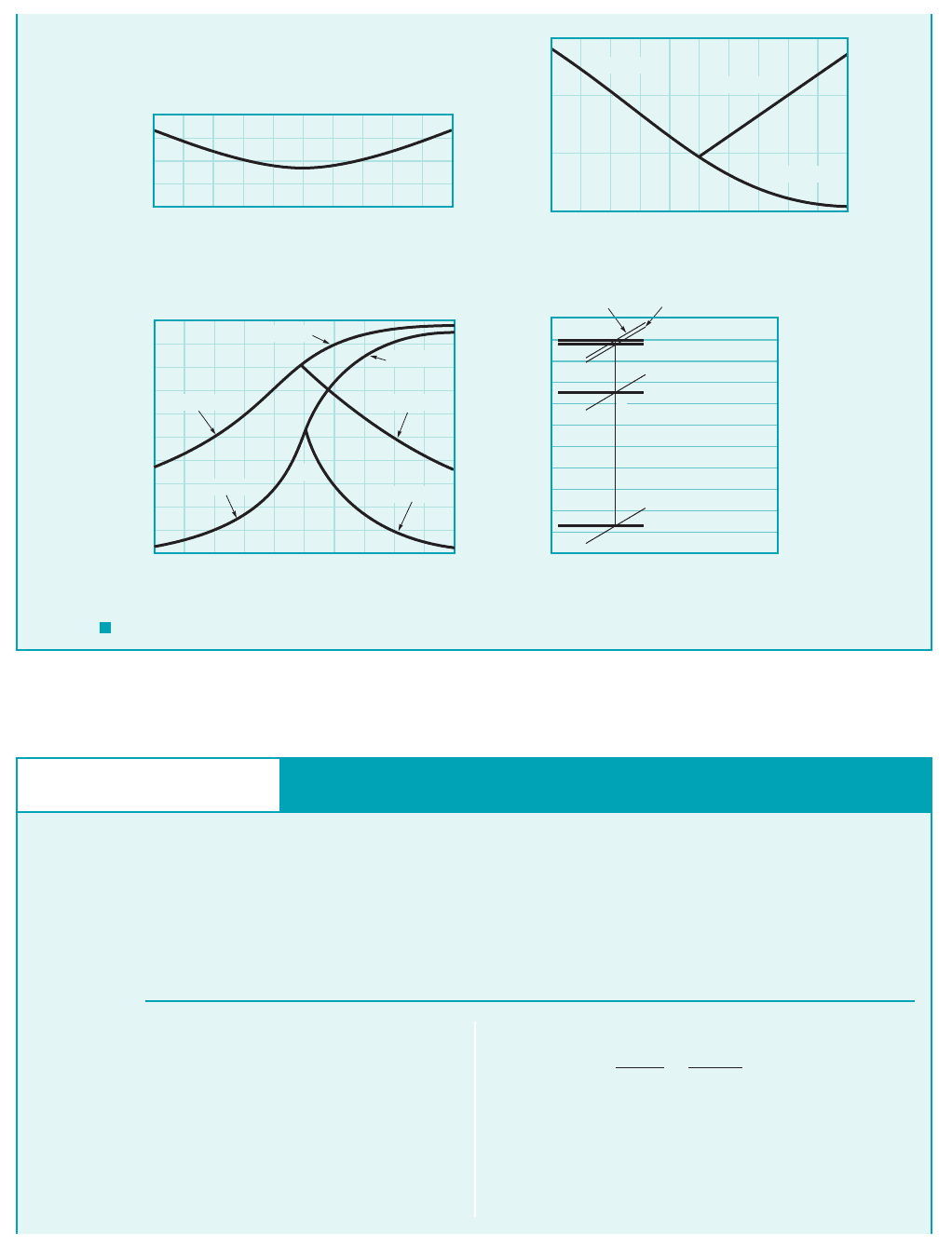
11.4 Isentropic Flow of an Ideal Gas 605
0.4
0.3
0.2
0.1
0
–0.5 –0.4 –0.2 0
(
a)(b)
x, m
x, m
0.2 0.4 0.5
3.0
2.0
1.0
0
–0.5 –0.4 –0.2 0 0.2 0.4 0.5
(
c)
x, m
–0.5 –0.4 –0.2 0 0.2 0.4 0.5
Ma
Supersonic
Supersonic
Subsonic
1.0
0.9
0.8
0.7
0.6
0.5
0.4
0.3
0.2
0.1
0.0
T
___
T
0
p
___
p
0
Subsonic
Subsonic
SupersonicSupersonic
Supersonic
Supersonic
T/T
0
p/p
0
(d)
310
290
270
250
230
210
190
170
150
130
110
90
0
d
b
c
p
e
= p
d
= 4 kPa (abs)
p
b
= 54 kPa (abs)
p
c
= 99 kPa (abs)
p
0
= 101 kPa (abs)
T
e
= T
d
= 112 K
T
b
= 240 K
T
c
= 286 K
T
0
= 288 K
T, K
r, m
J
_______
(kg • K)
s,
F I G U R E E11.9
GIVEN Air flows subsonically and isentropically through the
converging–diverging duct of Example 11.8.
FIND Graph the variation of Mach number, Ma, static temper-
ature to stagnation temperature ratio, and the static pressure
T
Ⲑ
T
0
,
Isentropic Unchoked Flow in a Converging–
Diverging Duct
E
XAMPLE 11.10
S
OLUTION
for this example is
(1)
With known values of duct area at different axial locations,
we can calculate corresponding area ratios, knowing
Having values of the area ratio, we can use
Fig. D.1 and obtain related values of Ma, and The fol-
lowing table summarizes flow quantities obtained in this manner.
The results are graphed in Fig. E11.10.
p
Ⲑ
p
0
.T
Ⲑ
T
0
,
A* ⫽ 0.07 m
2
.
A
Ⲑ
A*,
A* ⫽
A
1A
Ⲑ
A*2
⫽
0.10 m
2
1.4
⫽ 0.07 m
2
A*
Since for this example, at the isentropic
flow through the converging–diverging duct will be entirely
subsonic and not choked. For air flowing isentrop-
ically through the duct, we can use Fig. D.1 for flow field
quantities. Entering Fig. D.1 with we read off
and Even though the
duct flow is not choked in this example and does not there-
fore exist physically, it still represents a valid reference. For a
given isentropic flow, and are constants. Since A
at is equal to 1from Eq. 2 of Example 11.82,0.10 m
2
x ⫽ 0 m
A*p
0
, T
0
,
A*
A
Ⲑ
A* ⫽ 1.4.T
Ⲑ
T
0
⫽ 0.96,p
Ⲑ
p
0
⫽ 0.85,
Ma ⫽ 0.48
1k ⫽ 1.42
x ⫽ 0 m,Ma ⫽ 0.48
to stagnation pressure ratio, through the duct from
to for at Show
the corresponding temperature–entropy diagram.
x ⫽ 0 m.Ma ⫽ 0.48x ⫽⫹0.5 mx ⫽⫺0.5 m
p
Ⲑ
p
0
,
JWCL068_ch11_579-644.qxd 9/25/08 8:19 PM Page 605
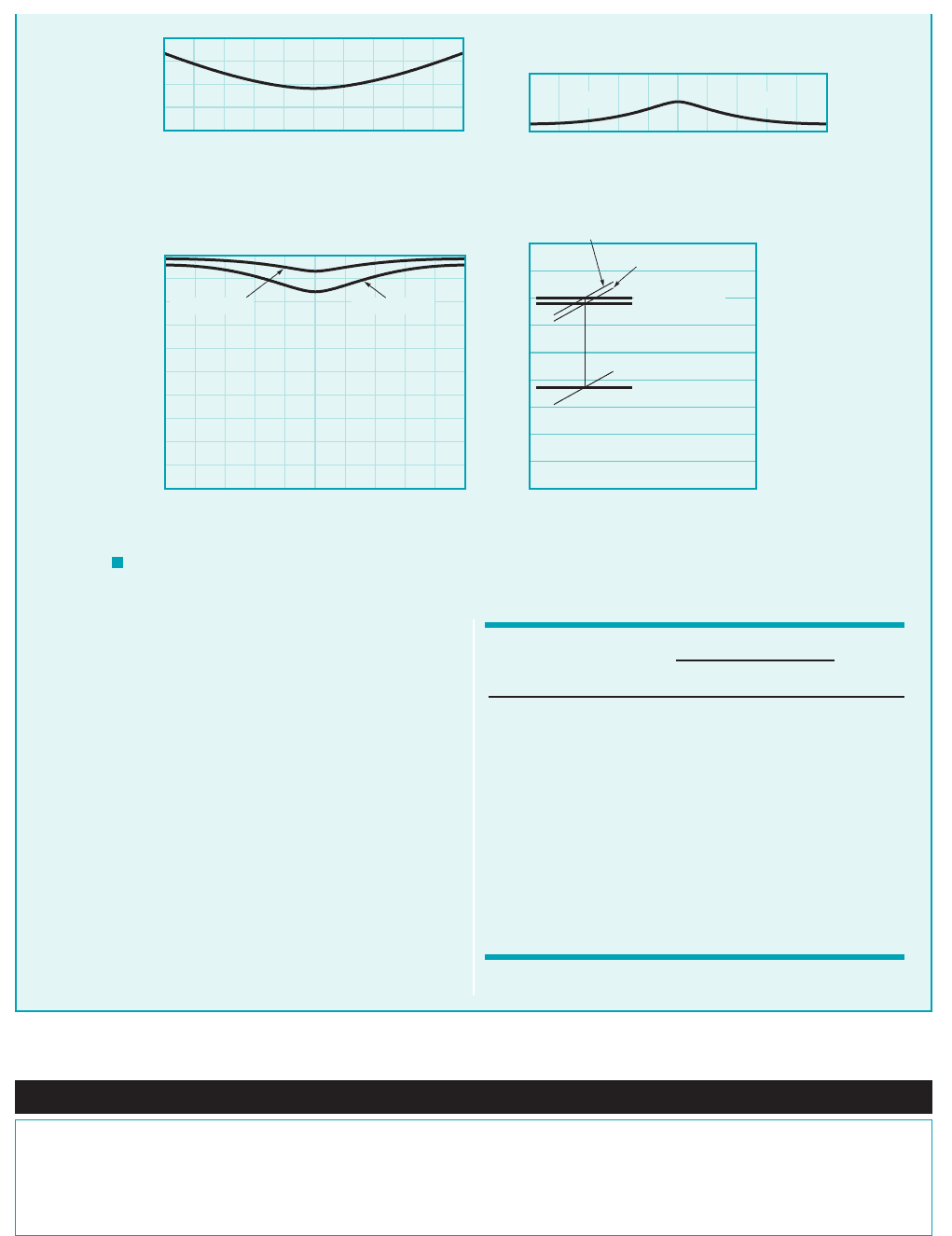
606 Chapter 11 ■ Compressible Flow
A more precise solution for the flow of this example could
have been obtained with isentropic flow equations by following
the steps outlined below.
1. Use Eq. 11.59 to get at knowing k and
2. From Eq. 11.71, obtain value of at knowing
k and Ma.
3. Determine knowing A and at
4. Determine at different axial locations, x.
5. Use Eq. 11.71 and from step 4 above to get values
of Mach numbers at different axial locations.
6. Use Eqs. 11.56 and 11.59 and Ma from step 5 above to
obtain and at different axial locations, x.
COMMENT There are an infinite number of subsonic, isen-
tropic flow solutions for the converging–diverging duct consid-
ered in this example 1one for any given Ma ⬍ 1 at x ⫽ 02.
p
Ⲑ
p
0
T
Ⲑ
T
0
A
Ⲑ
A*
A
Ⲑ
A*
x ⫽ 0.A
Ⲑ
A*A*
x ⫽ 0A
Ⲑ
A*
Ma ⫽ 0.48.
x ⫽ 0p
Ⲑ
p
0
F I G U R E E11.10
0.4
0.3
0.2
0.1
0
–0.5 –0.4 –0.2 0
(
a)(b)
x, m
x, m
0.2 0.4 0.5
1.0
0
–0.5 –0.4 –0.2 0 0.2 0.4 0.5
(
c)
x, m
–0.5 –0.4 –0.2 0 0.2 0.4 0.5
Ma
SubsonicSubsonic
1.0
0.9
0.8
0.7
0.6
0.5
0.4
0.3
0.2
0.1
0.0
T
___
T
0
p
___
p
0
Subsonic T/T
0
Subsonic p/p
0
(d)
296
292
288
284
280
276
272
268
264
260
0
b
a
, c
p
a
=
p
c
= 100 kPa (abs)
p
0
= 101 kPa (abs)
T, K
r, m
J
_______
(kg • K)
s,
p
b
= 86 kPa (abs)
T
b
= 276 K
T
0
= 288 K
T
a
= T
c
= 285 K
Calculated,
From Fig. D.1
x (m) Ma State
5.0 0.12 0.99 0.99 a
3.7 0.16 0.99 0.98
2.7 0.23 0.99 0.96
2.0 0.31 0.98 0.94
1.6 0.40 0.97 0.89
0 1.4 0.48 0.96 0.85 b
1.6 0.40 0.97 0.89
2.0 0.31 0.98 0.94
2.7 0.23 0.99 0.96
3.7 0.16 0.99 0.98
5.0 0.12 0.99 0.99 c⫹0.5
⫹0.4
⫹0.3
⫹0.2
⫹0.1
⫺0.1
⫺0.2
⫺0.3
⫺0.4
⫺0.5
p
Ⲑ
p
0
T
Ⲑ
T
0
A
Ⲑ
A*
Fluids in the News
Liquid knife A supersonic stream of liquid nitrogen is capable of
cutting through engineering materials like steel and concrete. Origi-
nally developed at the Idaho National Engineering Laboratory for
cutting open barrels of waste products, this technology is now more
widely available. The fast moving nitrogen enters the cracks and
crevices of the material being cut then expands rapidly and breaks up
the solid material it has penetrated. After doing its work, the nitrogen
gas simply becomes part of the atmosphere which is mostly nitrogen
already. This technology is also useful for stripping coatings even
from delicate surfaces.
JWCL068_ch11_579-644.qxd 9/25/08 8:19 PM Page 606
